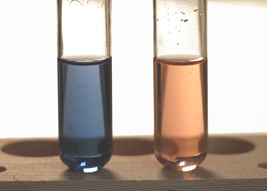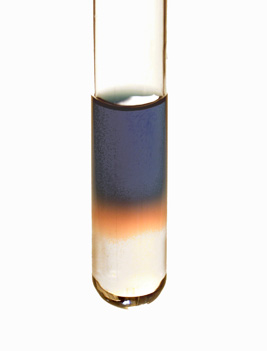The Hexaaquocobalt (II) - Tetrachlorocobalt(II) System |
|
| You will be examining the hexaaquocobalt (II) - tetrachlorocobalt(II)
equilibrium described by the following expression:
|
|
|
Pour 3 mL of deionized water into a clean, dry test tube using a graduated cylinder and label it test tube A. |
|
|
Clean and dry the graduated cylinder. Be sure to dry it very well! |
|
|
Pour 3mL of pure ethanol provided using the graduated cylinder into a second test tube, also cleaned and dried. Label this test tube B. |
|
|
Into test tubes A and B, you will add a small scoop of solid cobalt(II) chloride, CoCl2 (s). Before doing so, however, predict what color each of the resulting solutions will be. Write down your predictions in your laboratory notebook. |
|
|
Add the solid cobalt(II) chloride to each test tube using clean, dry metal spatulas. Stopper each tube and shake to dissolve the solid in solution. Observe and note the colors of each solution. Were your predictions correct? Record whether or not your predictions were correct and whether or not the observed changes were predicted by Le Chatlier. Be specific! |
 |
|
Add 3 mL of water to test tube A using a Pastuer pipet, adding liquid very slowly test tube A. The pipet tip should nearly rest on the bottom of the test tube. Do you note a color change? Does the color of the resulting solution indicate that Le Chatlier's principle was obeyed? |
|
|
Now, carefully and slowly add 3 mL of water into test tube B, making sure that the pipet tip nearly rests on the bottom of the test tube. Record your observations in your laboratory notebook. What phenomena do you observe? Does this change obey Le Chatlier's principle or not? You may need to discuss with your TA, instructor or other groups regarding this step. |
 |
|
Do not disturb the contents of test tube B by shaking or jarring. Try to maintain the separation being observed. |
|
|
Dispose of the contents of test tube A in the appropriate waste carboy. Keep test tube B for the next section. |
|
